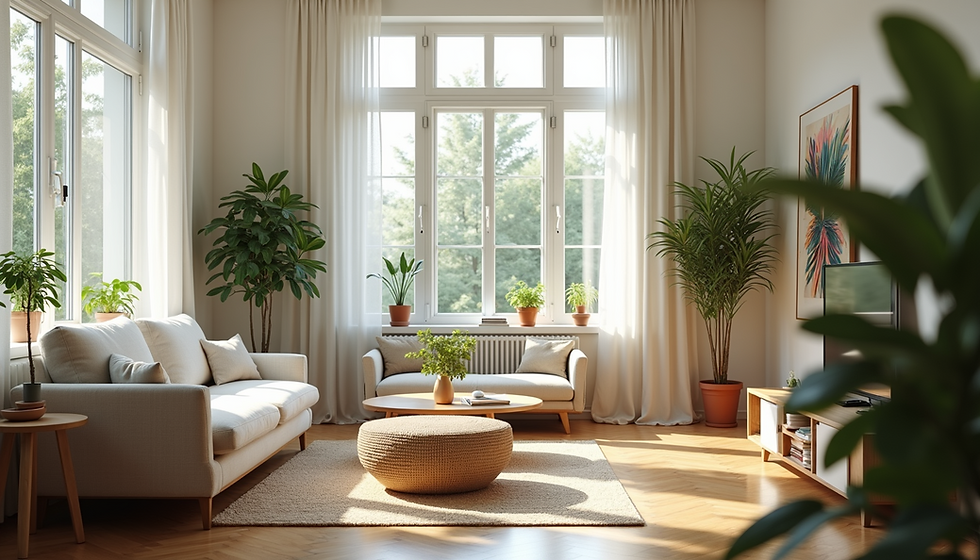Key Elements of a Well-Designed Home
- Param J Singh
- Oct 14
- 4 min read
Creating a well-designed home is more than just choosing attractive furniture or trendy colours. It involves a thoughtful combination of functionality, aesthetics, comfort, and personal style. A well-designed home not only looks beautiful but also enhances the quality of life for its occupants. Whether you are building a new house or renovating an existing one, understanding the key elements of good home design can help you make informed decisions that will stand the test of time.
What Makes a Well-Designed Home?
A well-designed home balances form and function. It should meet the practical needs of daily living while reflecting the personality and preferences of those who live there. Here are some essential aspects to consider:
Space Planning: Efficient use of space is crucial. Rooms should be sized appropriately and arranged logically to support the activities that take place in them. For example, the kitchen should be near the dining area, and bedrooms should be placed away from noisy living spaces.
Natural Light and Ventilation: Maximising natural light improves mood and reduces energy costs. Large windows, skylights, and open floor plans help bring in sunlight. Proper ventilation ensures fresh air circulation, which is vital for health and comfort.
Flow and Accessibility: A smooth flow between rooms makes a home feel spacious and welcoming. Hallways and doorways should be wide enough for easy movement, and accessibility features should be incorporated for all ages and abilities.
Storage Solutions: Clutter can ruin the look and feel of a home. Built-in storage, closets, and smart furniture help keep spaces organised and tidy.
Materials and Finishes: Choosing durable, easy-to-maintain materials ensures longevity. The finishes should complement the overall style and colour scheme of the home.

Designing a Well-Designed Home: Practical Tips
To create a home that is both beautiful and functional, consider these practical recommendations:
Start with a Clear Plan
Before buying furniture or paint, sketch a floor plan or use design software. This helps visualise the space and avoid costly mistakes.
Choose a Cohesive Style
Whether modern, traditional, or eclectic, stick to a consistent style throughout the home. This creates harmony and a sense of flow.
Invest in Quality Lighting
Layer your lighting with ambient, task, and accent lights. Use dimmers to adjust brightness according to mood and activity.
Incorporate Nature
Indoor plants, natural wood, and stone elements bring warmth and life to interiors.
Personalise with Art and Accessories
Display meaningful artwork, photographs, and unique decor items to make the space truly yours.
Consider Energy Efficiency
Use energy-saving appliances, LED bulbs, and insulation to reduce utility bills and environmental impact.
Hire Professionals When Needed
For complex projects, consulting experts can save time and ensure quality results. For example, home design services can provide tailored solutions that match your lifestyle and budget.

How much should I charge for design services?
If you are a professional designer or planning to offer design services, setting the right price is essential. Here are some factors to consider when determining your fees:
Experience and Expertise: More experienced designers can command higher rates.
Scope of Work: Charges vary depending on whether you provide full-service design, consultations, or specific tasks like space planning.
Project Size and Complexity: Larger or more complex projects require more time and resources.
Market Rates: Research what other designers in your area charge to stay competitive.
Pricing Models: Common approaches include hourly rates, flat fees, or percentage of the project cost.
Client Budget: Be flexible and transparent about costs to build trust.
For example, a beginner might charge INR 500-1000 per hour, while seasoned professionals could charge upwards of INR 3000 per hour. Flat fees for entire projects can range from INR 50,000 to several lakhs depending on the scale.
Offering clear contracts and detailed proposals helps avoid misunderstandings and ensures both parties are satisfied.
The Role of Lighting and Colour in a Well-Designed Home
Lighting and colour are powerful tools in home design. They influence mood, perception of space, and overall ambiance.
Lighting: Use a mix of natural and artificial lighting. Natural light is ideal during the day, while layered artificial lighting creates warmth and functionality at night. Consider the colour temperature of bulbs - warm light for relaxing areas and cool light for workspaces.
Colour: Choose colours that complement each other and suit the purpose of each room. Light colours make spaces feel larger and more open, while darker shades add coziness and drama. Accent walls and colourful accessories can add personality without overwhelming the space.
Experiment with different combinations to find what works best for your home. Remember, lighting and colour should work together to enhance the design, not compete with each other.

Creating Comfort and Functionality in Every Room
Comfort and functionality are at the heart of a well-designed home. Each room should serve its purpose while providing a pleasant environment.
Living Room: Arrange seating to encourage conversation and provide clear sightlines to focal points like a fireplace or TV. Use soft textiles like cushions and rugs for comfort.
Kitchen: Design for efficiency with the work triangle concept - the sink, stove, and refrigerator should be easily accessible. Include ample counter space and storage.
Bedroom: Prioritise restful colours, blackout curtains, and comfortable bedding. Keep clutter to a minimum.
Bathroom: Use moisture-resistant materials and good ventilation. Include storage for toiletries and towels.
Home Office: Ensure good lighting, ergonomic furniture, and minimal distractions.
By focusing on the needs of each space, you create a home that supports your lifestyle and well-being.
Designing a well-designed home is a rewarding process that combines creativity with practical planning. By paying attention to space, light, colour, comfort, and professional guidance, you can create a living environment that is both beautiful and functional for years to come.
.png)



Comments